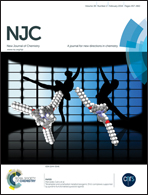Structure, conductive mechanism and electrochemical performances of LiFePO4/C doped with Mg2+, Cr3+ and Ti4+ by a carbothermal reduction method
Abstract
Mg2+, Cr3+ and Ti4+ with various valences at the ratio of 0.02 were used to dope, in order to improve the electrochemical performances of LiFePO4/C. LiFe0.98Mg0.02PO4/C (LFMPC), LiFe0.97Cr0.02PO4/C (LFCPC) and LiFe0.96Ti0.02PO4/C (LFTPC) were successfully synthesized by a carbothermal reduction method using FePO4·2H2O as the iron source and phenol-formaldehyde resin as the reducing agent and carbon source. The reaction mechanism is put forward. A LiFePO4 crystallite develops very well, and the lattice constants decrease after doping. LFTPC possesses the largest conductivity of 8.01 × 10−4 S cm−1, compared to LFMPC and LFCPC. The capacities of LFMPC, LFCPC and LFTPC at 0.1 C are 126.2 mA h g−1, 132.3 mA h g−1 and 134.7 mA h g−1 respectively, which are much larger than the 122.4 mA h g−1 of LiFePO4/C. LFTPC possesses the maximum capacity of 83.1 mA h g−1 at 3 C and a stable potential platform of 3.3 V. The energy gap of LFTPC is 0.61 eV, which is smaller than the 0.63 eV and 0.65 eV of Cr3+ and Mg2+ doped LiFePO4/C, respectively. The vacancy content of LFTPC is much more than for the other samples. This improves the electronic conductivity of doped LiFePO4/C. It is found that Ti4+ plays a significant role in improving the electronic conductivity and performances of LiFePO4/C.


 Please wait while we load your content...
Please wait while we load your content...